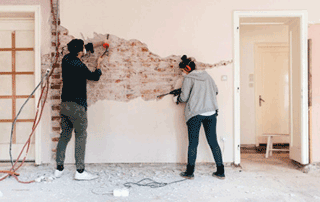Quote of the Week
“First-home buyers are well and truly in the market and are more buoyant than you might expect.”
realestate.com.au chief economist Nerida Conisbee
Vacancy Rate Remains Below 3%
 The latest data on residential vacancies shows that, despite a rise in the number of properties seeking tenants, the national vacancy rate remains well below 3% – the commonly accepted benchmark figure.
The latest data on residential vacancies shows that, despite a rise in the number of properties seeking tenants, the national vacancy rate remains well below 3% – the commonly accepted benchmark figure.
The current national vacancy rate, according to SQM Research, is 2.6% – compared to 2.3% a year ago.
All the capital cities except Sydney still have vacancy rates below 3%. And three capital cities – Adelaide, Canberra and Hobart – have vacancies below 1.5%, despite the increase in the number of properties available for rent. Melbourne, Brisbane, Perth and Darwin all have vacancy rates between 2.3% and 2.8%, according to the SQM figures for April. Sydney is the city that will have the most problems with vacancies – it’s now close to 4%.
One of the strengths of real estate across Australia is that vacancy rates were so low in most capital cities and in many regional centres as we entered the virus shutdown period. This has meant that as the number of properties seeking tenants has risen, most markets have been able to absorb that extra stock and still have acceptable vacancy rates.
Home Buyer Interest up 50% on 2019
 Buyer interest in the property market is up 50% on the same time last year, despite the challenges posed by Covid-19.
Buyer interest in the property market is up 50% on the same time last year, despite the challenges posed by Covid-19.
According to realestate.com.au, searches in Victoria and South Australia are up 40% this time last year. Increases in year-on-year growth have been recorded in every state with NSW up 39%, Queensland 33%, WA 49%, the NT 64% and the ACT up 91%.
“The first two weeks after lockdown we witnessed a dramatic fall off in searches,” realestate.com.au chief economist Nerida Conisbee says. “We expected to see that continue to drop off. But after that we saw an enormous pick up.”
First-home buyers are among those eagerly searching, with CoreLogic reporting that year-on-year, FHB inquiries rose 40% in April while investor inquiries fell 20%.
Domain reports that interstate searches for property have been rising since Covid-19 hit, with WA property recording a 120% uplift from March 26 to May 4, while interstate searches for the NT rose 153% and Queensland searches rose 108%.
Clearance Rates Up As Sentiment Rises
 Open homes and auctions were back in NSW, the ACT and the Northern Territory last week, bringing confidence back to the market with a 64% success rate from a total of 433 auctions nationally, the highest clearance rate since late March.
Open homes and auctions were back in NSW, the ACT and the Northern Territory last week, bringing confidence back to the market with a 64% success rate from a total of 433 auctions nationally, the highest clearance rate since late March.
The clearance rate was highest in Sydney (71% of 209 auctions), followed by Adelaide (62% from 29 auctions), and Canberra (62% from 50 auctions).
Auctions remained online in Melbourne, where buyers bought 60% of the 160 homes on offer while Brisbane sold 50% of the 23 homes put to auction.
In other evidence the property market remains robust, 3340 private sales were registered nationally.
“We’ve seen a notable drop in the number of homes pulled out from auctions, which signals a growing confidence among vendors,” says CoreLogic analyst Kevin Brogan.
There were also more homes sold at auctions than before auction, he says.
With South Australia and Queensland expected to lift bans over the coming weeks, volumes are set to rise, says SQM managing director Louis Christopher.
Gen Y Plan to Buy Soon
 A record number of Australians – 29% – plan to buy a new home in the next two years, shows new research by Rabobank.
A record number of Australians – 29% – plan to buy a new home in the next two years, shows new research by Rabobank.
Nearly one-third of those surveyed had been considering upgrading, downsizing, shifting location or getting into the property market for the first time.
The result eclipsed the previous high of 24% in 2016 when house prices rose by 15%, says Glenn Wealands, head of client experience of Rabobank.
Generation Y are the key drivers, with 32% of those aged 24 to 37 considering swapping homes or buying one for the first time.
“I think there’s definitely a lot of people exhibiting really good financial and having a sizeable deposit saved so were aware of what they could afford,” says Wealands.
“People are now seeing good opportunities in the market and perhaps also feeling FOMO.”
Experts advise that, if potential purchasers aren’t adversely affected by Covid-19, now could be a good time to buy, with interest rates ultra low, reduced competition from other buyers and the possibility of buying well in a weak market.
Lockdown Encourages DIY Jobs
 Renovation projects are behind the increased spending on hardware and garden supplies since the Covid-19 lockdown.
Renovation projects are behind the increased spending on hardware and garden supplies since the Covid-19 lockdown.
Overall spending on household goods was up 9% in March, according to retail figures released by the Australian Bureau of Statistics.
However, hardware and garden supply purchases rose 17% while electrical and electronic spending was 11% higher, compensating for falls in other sections of the retail sector.
The Housing Industry Association’s Victorian executive director Fiona Nield says many people who still have work but are stuck at home are renovating rather than spending money on socialising.
“Some Australians who are securely employed have started to think about how they can increase the value of their biggest asset, their house,” Nield says.
The anecdotal evidence suggests people who work from home are taking on small home renovation projects. This is likely because they are saving money on travel, big things like holidays and little things like eating out and other recreation, she says.




